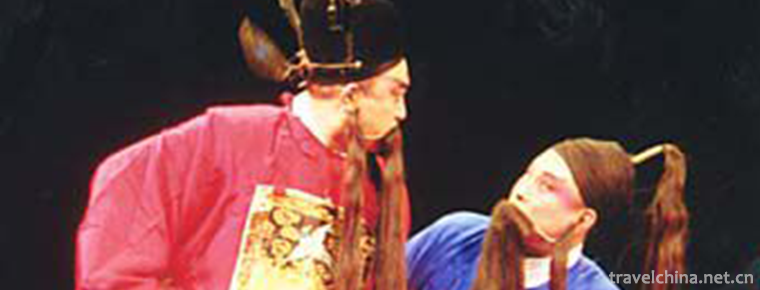Yingge Liushu
Yingge Liushu
Yingge Liushu, also known as Yingge Liuzi, is a traditional art form of rap and singing spread in southwestern Shandong, southern Shandong, Eastern Henan and Northern Jiangsu. Legend has it that the Liuzi opera card "Yinggeliu" originated in the Ming Dynasty evolved, and on this basis, the book of pendants was derived.
On June 7, 2008, the "Yingge Liu Shu" declared by Heze City, Shandong Province, was listed in the second batch of national intangible cultural heritage list with the approval of the State Council.
historical origin
According to records, Yingge Liushu has a history of at least 200 years.
Although Yingge Liushu has a long history, it is not widely circulated. The most influential artist in Southwest Shandong in the past hundred years, and also the earliest known Yinggeliu calligrapher in Heze area, is Zhang Xianzi in Zhongdi Circle of Cao County (1848-1928, lost name). The flourishing period of Yingge Liushu is the active era of Zhang Xianzi. Zhang's heir was Zhang Baoliang of Benzhuang, and the next generation was Zheng Yukun of Zhengzhuang, Cao Zhitian of Dingtao (1904-1976). Zheng Yukun passed Yingge Liushu's skill to Gao Zhijun of Heze in his later years, and now this rare song is only his heir.
Representative Program
Yingge Liushu's main programs are "stealing poetry", "miao Chang yinzi", "roll foil", "rabbit kidnap pawn ticket" and other sixty sections; Longfeng bracelet","sweater story","Yang Zongying down the mountain"more than ten long books.
Singing Form
Yingge Liushu sings white and white, which is a singing style used repeatedly. The singing form also has three strings. The basic aria is four sentences, and the rest are deepened accordingly. And after the four sentences, there must be a tail-lapping liner "where, ah, ah, ah, hm".
The singing form of Yingge Liushu is relatively simple, mostly in the double-file of playing and singing. Yinggeliu's catalogues are very rich, some of them are elegant and difficult to understand, the other part is easy to understand, fresh and simple, showing the diversity of the source of the catalogue. Its aria music is rich and colorful in the early stage, but simple and rigid in the later stage. It is closely related to Liuzi Opera and local operas, and has a variety of research values. It directly promotes the book of pendants, and has an important influence on its music, repertoire, performance form and style.
Inheritance Significance
Yingge Liushu is closely related to Liuzi Opera and local Xiaoqu, and has many research values. It directly promotes the book of pendants, and has an important influence on its music, repertoire, performance form and style.
Yingge Liushu is one of the rare traditional operas in northern Chinese opera. It had a great influence in the border area of Shandong, Henan and Anhui in the middle and late Qing Dynasty. But in the early years of the Republic of China, the rapid shrinkage, Henan and Anhui Branches have been basically silent, only Heze left a claw of mud, known as "living fossils".


-
1.Steamed perch with scallion and black beans
Steamed bass cooking techniques are mainly steamed dishes, and their taste is salty and fresh. Steamed perch is one of the famous traditional dishes in Guangdong province
Time 2018-11-02 -
2.Mount Tianzhu Scenic Area
Tianzhu Mountain Scenic Spot, located in the west of Qianshan City, Anqing City, Anhui Province, is known as "the first mountain in the Yangtze River and Huaihe River" for its main peak
Time 2018-12-08 -
3.Shanghai Museum of Natural History
The Shanghai Museum of Nature (Shanghai Science and Technology Museum Natural Branch) is one of the largest natural museums in China. Located in the center of Shanghai, Address: 260 Yan'an East Road,
Time 2018-12-15 -
4.Chengjiang biota
Chengjiang biota is located near Maotianshan, Chengjiang, Yunnan Province, China. The stratum of Chengjiang biota is yellow-green silty shale of Yudanshan section of Qiongzhusi Formation of Lower Camb
Time 2019-01-05 -
5.Shenyang Forest Wildlife Park
Shenyang Forest Zoo is a state-level forest wildlife park approved by the State Forestry Administration and the Ministry of Construction. Located in the Chebanshan International Scenic Tourism Develop
Time 2019-02-08 -
6.Zhangye National Wetland Park
Zhangye National Wetland Park is located in the northern suburbs of Ganzhou District, Zhangye City, which is closely linked with the urban area. Wetland area of 62,000 mu, the main body is located in
Time 2019-03-16 -
7.Tibetan costume
Tibetan costumes Tibetan men's clothes are divided into three categories: labor dress, superfluous dress and warrior dress. Women's clothes change greatly in festivals, major events in life and etique
Time 2019-04-05 -
8.She Costume
She nationality's men and women's clothing is basically the same as that of the local Han people. However, the She ethnic costumes in Fujian and Zhejiang provinces with relatively concentrated populat
Time 2019-06-14 -
9.Sayerhao of Tujia Nationality
"Sayeer Hao" of Tujia nationality in Changyang, Hubei Province is a kind of sacrificial song and dance of Tujia nationality in the middle reaches of Qingjiang River valley. "Sayer Haw&q
Time 2019-06-23 -
10.Congratulations
Congratulations, also eulogies, Mongolian folk literature form, China's national intangible cultural heritage. Praise is a traditional folk literature form of Mongolian nomadic people in northern Chin
Time 2019-08-10 -
11.Sichuan University of Arts and Science
Sichuan Academy of Arts and Sciences, located in Dazhou City, Eastern Sichuan Province, has a history of running higher education which can be traced back to Longshan Academy in late Qing Dynasty, whi
Time 2019-08-31 -
12.Tourist guide to Chengdu Giant Panda Base
Chengdu Giant Panda Breeding Research Base is located in Futou mountain, north suburb of Chengdu City, Sichuan Province. It is 10 kilometers away from the urban area. There is a wide panda Avenue connecting with the urban area.
Time 2020-12-13